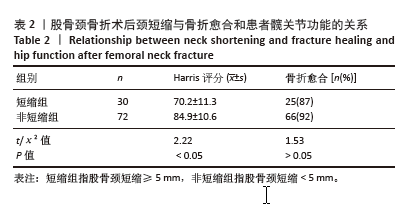[1] 张樱严,荣芳,陆叶,等. ERAS结合FNS内固定治疗股骨颈骨折效果观察[J]. 中国骨与关节杂志,2023,12(6):419-424.
[2] 黄兆波,尤加省,杨杰.新鲜股骨颈骨折行闭合复位三枚空心螺钉加压固定治疗的临床疗效及影响临床结局的因素分析[J].全科医学临床与教育,2020,18(12):1080-1083.
[3] 高杨博,胡泽华,高伟韬,等.不同构型内固定螺钉对治疗股骨颈骨折影响的有限元分析[J]. 中南大学学报(自然科学版),2024,55(9): 3306-3314.
[4] 余霄,张迪峰,宋蒙胜,等.骨质疏松性股骨颈骨折空心钉内固定术后股骨颈短缩对髋关节生物力学影响的有限元分析[J].中华医学杂志,2020,100(33):2628-2632.
[5] 王颖,马剑雄,柏豪豪,等.股骨颈骨折术后不同复位质量的力学特性分析[J]. 医用生物力学,2021,36(2):284-289.
[6] 汪天豪,梁晓龙,郑恺,等.股骨颈动力交叉钉系统与空心加压螺钉治疗老年股骨颈骨折短期随访的对比[J].中国组织工程研究, 2023,27(36):5828-5833.
[7] SAXER F, STUDER P, JAKOB M, et al. Minimally invasive anterior muscle-sparing versus a transgluteal approach for hemiarthroplasty in femoral neck fractures-a prospective randomised controlled trial including 190 elderly patients. BMC Geriatr. 2018;18(1):222.
[8] VAN DER SIJP MPL, SCHIPPER IB, KEIZER SB, et al. Prospective comparison of the anterior and lateral approach in hemiarthroplasty for hip fractures: a study protocol. BMC Musculoskelet Disord. 2017;18(1): 361.
[9] FELTON J, SLOBOGEAN GP, JACKSON SS, et al. Femoral neck shortening after hip fracture fixation is associated with inferior hip function: Results From the FAITH Trial. J Orthop Trauma. 2019;33(10):487-496.
[10] 李威, 周毅. 切开复位内固定与闭合复位内固定治疗青壮年股骨颈骨折的疗效比较[J]. 中国骨与关节损伤杂志,2020,35(6):598-600.
[11] 李伟龙, 余霄, 庞清江. 股骨颈骨折内固定术后股骨颈短缩的相关研究进展[J]. 中华骨科杂志,2016,36(6):378-384.
[12] WANG CT, CHEN JW, WU K, et al. Suboptimal outcomes after closed reduction and internal fixation of displaced femoral neck fractures in middle-aged patients: is internal fixation adequate in this age group? BMC Musculoskelet Disord. 2018;19(1):190.
[13] HAIDER T, SCHNABEL J, HOCHPÖCHLER J, et al. Femoral shortening does not impair functional outcome after internal fixation of femoral neck fractures in non-geriatric patients. Arch Orthop Trauma Surg. 2018;138(11):1511-1517.
[14] DONG Q, HAN Z, ZHANG YG, et al. Comparison of transverse cancellous lag screw and ordinary cannulated screw fixations in treatment of vertical femoral neck fractures. Orthop Surg. 2019;11(4):595-603.
[15] 吴伟,喻爱喜,漆白文,等. 颈短缩对股骨头颈生物力学的影响[J]. 中华实验外科杂志,2017,34(11):1865-1867.
[16] GIORDANO V, ALVES DD, PAES RP, et al. The role of the medial plate for Pauwels type III femoral neck fracture: a comparative mechanical study using two fixations with cannulated screws. J Exp Orthop. 2019;6(1):18.
[17] 顾叶,王秋霏,方涛,等. 动力交叉螺钉应用于不稳定型股骨颈骨折的生物力学分析[J]. 中国组织工程研究,2023,27(22):3481-3485.
[18] 潘永飞,何一成,张晓峰.股骨颈骨折空心螺钉固定术后股骨颈短缩影响因素的初步分析[J].当代医学,2019,25(33):21-24.
[19] 吴研飞,马剑雄,赵兴文,等. 两种构型空心钉固定股骨颈骨折的荟萃分析[J]. 中国矫形外科杂志,2023,31(6):515-519.
[23] BORAIAH S, PAUL O, HAMMOUD S, et al. Predictable healing of femoral neck fractures treated with intraoperative compression and length-stable implants. J Trauma. 2010;69(1):142-147.
[21] 梁金龙,陆声.髋关节旋转中心测量方法的研究进展[J].中国矫形外科杂志,2014,22(6):512-515.
[22] SLOBOGEAN GP, STOCKTON DJ, ZENG BF, et al. Femoral neck shortening in adult patients under the age of 55 years is associated with worse functional outcomes: analysis of the prospective multi-center study of hip fracture outcomes in China (SHOC). Injury. 2017;48(8):1837-1842.
[23] 黄方敏,勘武生,蔡宗强,等. 影响股骨颈骨折内固定后髋关节功能的多因素分析[J]. 中国组织工程研究,2008,12(26):5135-5138.
[24] HARRIS WH. Traumatic arthritis of the hip after dislocation and acetabular fractures: treatment by mold arthroplasty:an end-result study using a new method of result evaluation. J Bone Joint Surg Am. 1969;51(4):737-755.
[25] 杨光,左楠,祁宝昌,等. 骨科手术机器人辅助经皮空心螺钉内固定治疗股骨颈骨折的疗效分析[J]. 首都医科大学学报,2024, 45(5):783-787.
[26] 侯洪涛,刘立平,李无阴,等. 正位Garden指数对Garden Ⅲ型股骨颈骨折移位程度的评价及其价值[J]. 中华创伤杂志,2022,38(10): 904-908.
[27] BARTELS S, GJERTSEN JE, FRIHAGEN F, et al. Low bone density and high morbidity in patients between 55 and 70 years with displaced femoral neck fractures: a case-control study of 50 patients vs 150 normal controls. BMC Musculoskelet Disord. 2019;20(1):371.
[28] 曹发奇,周武,刘国辉,等.股骨颈骨折复位内固定术后股骨头坏死的相关因素分析[J].中华骨科杂志,2017,37(17):1088-1092.
[29] GARDEN RS. Stability and union subcapital fractures of the femur. J Bone Joint Surg Br. 1964;46:630-647.
[30] RAAYMAKERS EL. The non-operative treatment of impacted femoral fractures. Injury. 2002;33(1):8-14.
[31] TAHA ME, AUDIGC L, SICGCL G, et al. Factors prodicting secondary displacement after non-operative treatment of undisplaced femoral neck fractures. Arch Orthop Trautna Surg. 2015;135(2):243-249.
[32] POLAT A, MISIR A, BUYUKKUSCU MO, et al. Factors Associated with Femoral Neck Shortening After Closed or Open Reduction and Screw Fixation. Indian J Orthop. 2021;56(2):303-311.
[33] Felton J, Slobogean GP, Jackson SS, et al. Femoral neck shortening after hip fracture fixation is associated with inferior hip function: results from the FAITH Trial. J Orthop Trauma. 2019;33(10): 487-496.
[34] 夏希,刘智. 老年股骨颈骨折空心螺钉固定术后颈短缩的测量及其对髋关节功能的影响[J].中华创伤骨科杂志,2014,16(8):651-655.
[35] CHEN X, ZHANG J, WANG X, et al. Incidence of and factors influencing femoral neck shortening in elderly patients after fracture fixation with multiple cancellous screws. Med Sci Monit. 2017;26(23):1456-1463.
[36] BARQUET A, GIANNOUDIS PV, GELINK A, et al. Femoral neck fractures after removal of hardware in healed trochanteric fractures. Injury. 2017;48(12):2619-2624.
[37] 牟帅,肖鹏,张建亮,等.股骨颈骨折复位内固定后股骨颈短缩的发生率及相关因素[J].中国组织工程研究,2020,24(21):3304-3309.
[38] 郎俊哲,吴聪聪,金建锋,等.肌少症对股骨颈骨折行髋关节置换术后早期功能的影响分析[J].中国骨伤,2018,31(9):835-839.
[39] WEIL YA, QAWASMI F, LIEBERGALL M, et al. Use of fully threaded cannulated screws decreases femoral neck shortening after fixation of femoral neck fractures. Arch Orthop Trauma Surg. 2018;138(5): 661-667.
[40] SLOBOGEAN GP, SPRAGUE SA, SCOTT T, et al. Management of young femoral neck fractures: is there a consensus? Injury. 2015;46(3): 435-440.
[41] 陈方,刘修其,邓钰泓,等. 空心拉力螺钉“F”形固定Pauwels Ⅲ型股骨颈骨折[J]. 中国矫形外科杂志,2022,30(10):954-957.
[42] 相庚,冯亚非,程建刚,等. 单头与双头螺纹空心钉固定治疗 Pauwels Ⅲ型股骨颈骨折的生物力学性能比较[J]. 中华创伤骨科杂 志,2019,21(12):1064-1068.
[43] 朱春晖,刘刚,陈伟. 股骨颈动力交叉钉系统与空心加压螺钉治疗中青年Pauwels Ⅲ型股骨颈骨折的疗效比较[J]. 中国微创外科杂志, 2024,24(9):610-616.
[44] MAYMAN D, VASARHELYI EM, LONG W, et al. Computer-assisted guidewire insertion for hip fracture fixation. J Orthop Trauma. 2005;19: 610-615. |



